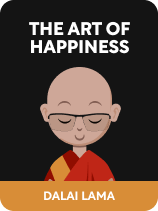

This article is an excerpt from the Shortform book guide to "The Art of Happiness" by Dalai Lama. Shortform has the world's best summaries and analyses of books you should be reading.
Like this article? Sign up for a free trial here .
What is happiness at its core? Do you think happiness is a natural human state?
According to the Dalai Lama, happiness is not merely an emotional state, but a mental and intellectual one. It’s about being content with your life on all levels. In his book The Art of Happiness (co-authored with Howard C. Cutler), he proposes that all humans should seek out happiness by training themselves to be happy in four different ways.
Here is how to cultivate true happiness, according to the spiritual leader Dalai Lama.
Your Purpose Is to Seek Happiness
Some westerners see striving for personal happiness as a selfish act. But the Dalai Lama argues the opposite is the case: Unhappy people are more self-absorbed than happy people, who are compassionate, helpful, and generous. That’s why it is your purpose as a human to seek happiness.
(Shortform note: Aristotle also believed that your purpose in life is to achieve happiness. According to him, every goal you set in life, however distant it may seem from happiness, actually is in service of attaining happiness. Let’s say you join a high-intensity fitness program, which, with its grueling exercises, may not seem in service of your happiness. However, when you look at the micro-goals of joining this program, you see they serve the macro-goal of happiness: You join the program to get fit. You get fit to be healthy. You become healthy to be happier.)
(Shortform note: Maslow’s Hierarchy of Needs echoes the idea that we’re able to do our best for others when we’re happy and explains why this might be the case. Abraham Maslow posited that human motivation is tiered: We’re first motivated to satisfy simple needs—for shelter, food, and so on—and only motivated to tend to higher-tier needs—friendship, love, and the like—once the simple needs are met. Therefore, until we reach the highest tier, self-actualization—comparable to the attainment of happiness as described by the Dalai Lama—we can’t practice generosity toward others because we’re too busy meeting essential needs.)
You Can Achieve Happiness Because You’re Innately Compassionate
According to the Dalai Lama, happiness is your natural predisposition because you’re innately compassionate and loving. This belief stems from the Buddhist doctrine of Buddha Nature, the belief in humans’ intrinsic state of purity and positivity.
(Shortform note: Buddhists of different schools perceive Buddha Nature differently. Some believe that you’re born with the seed of Buddha Nature but must nurture it into bloom yourself. Others believe that your Buddha Nature is already fully developed but hidden by your misconceptions of the world. Your goal, then, is to rid yourself of those misconceptions.)
If you don’t believe in Buddha Nature, you’ll find proof of humans’ innate compassion by observing our behavior, claims the Dalai Lama: Children need the compassion, care, and love of their families to survive. Because they’re necessary to survival, these emotions must be fundamental to human nature. We’ll call such innate, life-sustaining emotions positive emotions. Cutler adds that there’s scientific research proving humans are inherently kind and altruistic.
(Shortform note: While there is, as the Dalai Lama and Cutler say, evidence of humans’ innate altruism, kindness, and caring, we can’t deny the existence of war, poverty, and hatred. Researchers have tried to account for this by proposing that in the hunter-gatherer societies of 15,000 years ago (and in modern-day ones), altruism was an important survival mechanism. However, when humans developed an agricultural lifestyle, altruism was by necessity replaced with self-serving behavior and hierarchies, which led to conflict. We’ll discuss why later in the chapter.)

———End of Preview———
Like what you just read? Read the rest of the world's best book summary and analysis of Dalai Lama's "The Art of Happiness" at Shortform .
Here's what you'll find in our full The Art of Happiness summary :
- The Dalai Lama's Buddhist path toward happiness
- The use of scientific evidence to support the Dalai Lama's beliefs
- Concrete actions you can take to improve your outlook on life, relationships, and resilience






